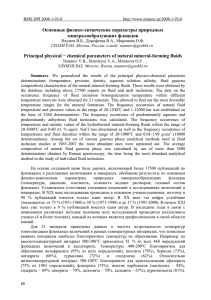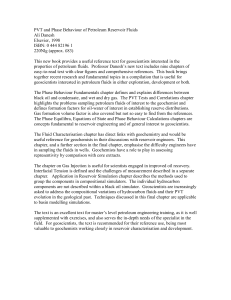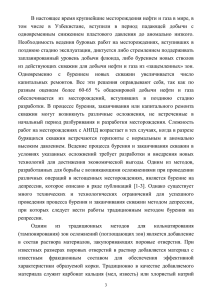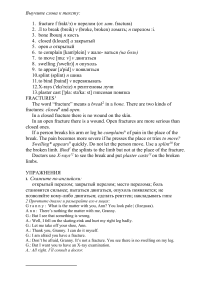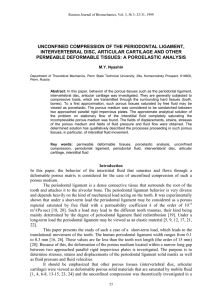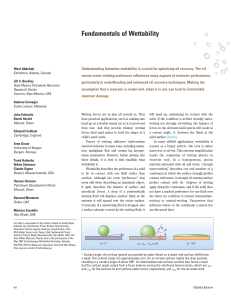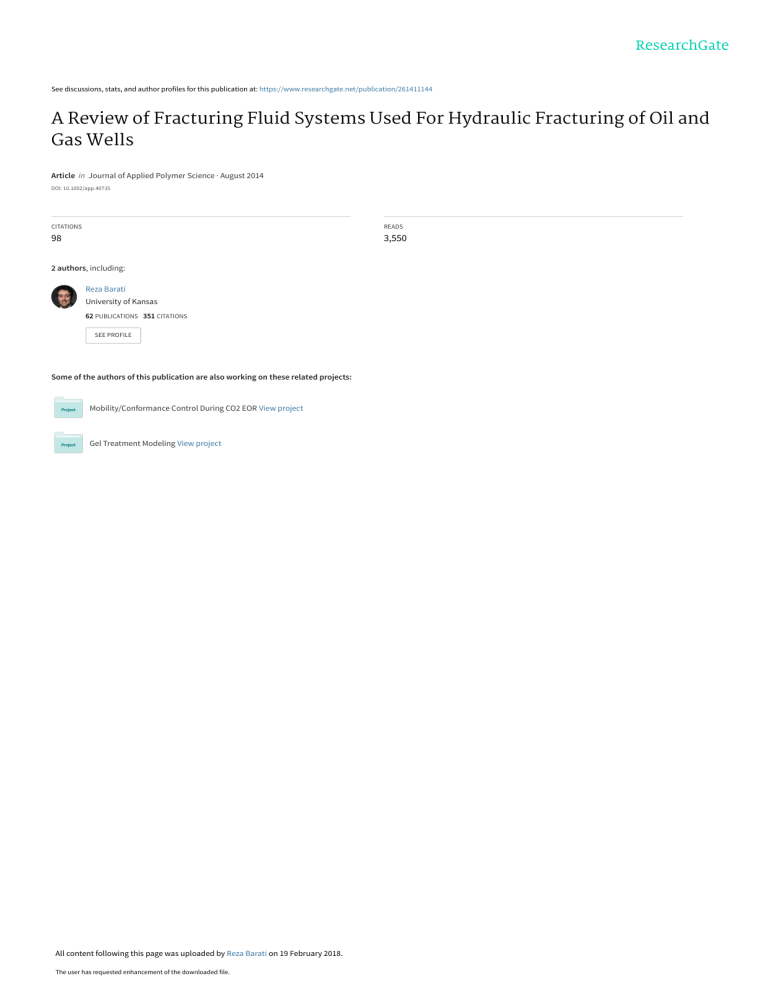
See discussions, stats, and author profiles for this publication at: https://www.researchgate.net/publication/261411144 A Review of Fracturing Fluid Systems Used For Hydraulic Fracturing of Oil and Gas Wells Article in Journal of Applied Polymer Science · August 2014 DOI: 10.1002/app.40735 CITATIONS READS 98 3,550 2 authors, including: Reza Barati University of Kansas 62 PUBLICATIONS 351 CITATIONS SEE PROFILE Some of the authors of this publication are also working on these related projects: Mobility/Conformance Control During CO2 EOR View project Gel Treatment Modeling View project All content following this page was uploaded by Reza Barati on 19 February 2018. The user has requested enhancement of the downloaded file. REVIEW A Review of Fracturing Fluid Systems Used For Hydraulic Fracturing of Oil and Gas Wells Reza Barati,1 Jenn-Tai Liang1,2 1 Department of Chemical and Petroleum Engineering, The University of Kansas, Lawrence, Kansas 66045 2 Tertiary Oil Recovery Program, The University of Kansas, Lawrence, Kansas 66045 Correspondence to: R. Barati (E - mail: [email protected]) Hydraulic fracturing has been used by the oil and gas industry as a way to boost hydrocarbon production since 1947. Recent advances in fracturing technologies, such as multistage fracturing in horizontal wells, are responsible for the latest hydrocarbon production boom in the US. Linear or crosslinked guars are the most commonly used fluids in traditional fracturing operations. The main functions of these fluids are to open/propagate the fractures and transport proppants into the fractures. Proppants are usually applied to form a thin layer between fracture faces to prop the fractures open at the end of the fracturing process. Chemical breakers are used to break the polymers at the end of the fracturing process so as to provide highly conductive fractures. Concerns over fracture conductivity damage by viscous fluids in ultra-tight formations found in unconventional reservoirs prompted the industry to develop an alternative fracturing fluid called “slickwater”. It consists mainly of water with a very low concentration of linear polymer. The low concentration polymer serves primarily to reduce the friction loss along the flow lines. Proppant-carrying capability of this type of fluids is still a subject of debate among industry experts. Constraints on local water availability and the potential for damage to formations have led the industry to develop other types of fracturing fluids such as viscoelastic surfactants and energized fluids. This article reviews both the traditional viscous fluids used in conventional hydraulic fracturing operations as well as the new family of fluids being develC 2014 Wiley Periodicals, Inc. J. Appl. Polym. Sci. 2014, 131, 40735. oped for both traditional and unconventional reservoirs. V ABSTRACT: KEYWORDS: breaker-free fluids; energized fluids; fracturing fluids; guar alternatives; guar-based fluids; hydraulic fracturing; slick- water; viscoelastic surfactants; water-based polymers Received 30 December 2013; accepted 17 March 2014 DOI: 10.1002/app.40735 INTRODUCTION Hydraulic fracturing is a commonly used technique to stimulate hydrocarbon production by creating a network of highly conductive fractures in the area surrounding a wellbore.1 The network of fractures created not only improves hydraulic conductivity of the reservoir rock but also increases the surface area contributing to hydrocarbon production. This technique can be applied in vertical as well as horizontal wells (Figure 1). The first hydraulic fracturing job was performed in 1947 in the Hugoton field, Kansas.2 This job was done in a vertical well where a simple two-wing fracture [Figure 1(a)] was created to improve gas production. Recent advancements in horizontal drilling and fracturing technologies have made it possible to conduct multistage fracturing in horizontal wells [Figure 1(b)]. The tremendous increase in hydrocarbon productivity resulting from the vast network of fractures created during the process has made it economically feasible for the oil and gas industry to tap into the vast hydrocarbon resources in previously undeveloped tight unconventional reservoirs. To create fractures in reservoir rock, a fracturing fluid is injected under high pressure to hydraulically crack the rock open. During early years, oil-based fracturing fluids were used in hydraulic fracturing. The first fracturing job performed in the Hugoton field actually used gasoline-based napalm as the fracturing fluid.2 The environmental and safety concerns associated with oil-based fracturing fluids prompted the industry to develop more environmentally friendly water-based fracturing fluids. However, oilbased fracturing fluids are being considered again due to concerns about potential damage caused by water-based fracturing fluids to water-sensitive formations with high clay content. To reduce the amount of water used for hydraulic fracturing in unconventional reservoirs, liquified natural gas has also been proposed as an alternative to water-based fracturing fluids.1 Water-based viscous polymeric fracturing fluids play very important roles in hydraulic fracturing. Guar gum is one of the oldest examples of water-based fracturing fluids developed by the industry. Both the linear and the crosslinked forms of guar gum are still widely used in hydraulic fracturing today. The C 2014 Wiley Periodicals, Inc. V WWW.MATERIALSVIEWS.COM 40735 (1 of 11) J. APPL. POLYM. SCI. 2014, DOI: 10.1002/APP.40735 REVIEW WILEYONLINELIBRARY.COM/APP Dr. Reza Barati is an Assistant Professor of Chemical and Petroleum Engineering at the University of Kansas (KU). After receiving his PhD in Petroleum Engineering, he worked as an Assistant Research Scientist for the Enhanced Oil Recovery Institute at the University of Wyoming before starting his career at KU in August 2012. Reservoir stimulation fluids have been his main area of research and he has published several papers in the areas of hydraulic fracturing fluids. Dr. Jenn-Tai Liang is a professor in the Chemical & Petroleum Engineering Department at The University of Kansas. He also serves as the director of Tertiary Oil Recovery Program, a research center funded by the government/industry to develop advanced technologies for improved hydrocarbon recovery applications. The main focus of his current research activities is on the use of nanotechnologies for improved hydrocarbon recovery in conventional and unconventional reservoirs. fracturing process starts by injecting a fluid under pressure to crack open the reservoir rock. Once the reservoir rock is cracked, the fracturing fluid enters the cracks and starts propagating fractures away from the wellbore. The advantage of using viscous fracturing fluids with wall-building characteristics, such as guar polymers or gels, is that, under pressure, a layer of filter cake will quickly form on the fracture faces preventing further leakoff of the fracturing fluids into the surrounding formation rock. In this way, the amount of fracturing fluid needed for a given fracture length generated can be much less than that using nonviscous fracturing fluids such as water with no filter cake to prevent the fluid leakoff.1,3 However, polymers of different molecular weights and characteristics may exhibit weak wallbuilding capabilities and invade high permeability formations to form internal filter cake that causes undesirable damage to the reservoir rock. Another important function of the fracturing fluid is to carry and transport proppants into the fracture. Proppants form a thin layer between the fracture faces to keep the fractures open at the end of the fracturing process. The very first fracturing job used river sand as the proppant. Currently, the most commonly used proppants are 20/40 mesh sand, which account for 85% of the proppant use by the industry.4 Other commonly used proppants include resin-coated sand, intermediate-strength proppants, ceramic proppants, and high-strength proppants such as sintered bauxite and zirconium oxide.1 Without proppants, the fractures will close after the pumping of fracturing fluids under high pressure is ceased, resulting in minimal or no gain of hydrocarbon productivity. Usually, viscous hydraulic fracturing fluids (e.g., polymers or gels) are required to ensure proper proppant transport and the even distribution of proppant along the fractures. Harris et al.5 reported that metal crosslinked fracturing fluids transport proppant more efficiently than borate crosslinked fluids. Both fluids exhibit better proppant transport characteristics than noncrosslinked fluids. Slickwater fracturing fluids are the least efficient when it comes to proppant transport. High velocities must be achieved within the fracture to prevent the proppants from settling in the near WWW.MATERIALSVIEWS.COM wellbore region of the fracture(s) or accumulating at the bottom of the fracture, limiting the effective fracture height.6 Viscous fracturing fluids in the fractures and the filter cakes formed on the fracture faces must be degraded at the end of the fracturing process to avoid damaging the fracture conductivity. Oxidizers or enzymes are the most commonly used breakers for fracturing fluid cleanup.1,3 Concerns over formation damage with viscous hydraulic fracturing fluids in very tight formations7 found in unconventional reservoirs prompted the industry to develop another type of hydraulic fracturing fluids called “slickwater”. This type of fracturing fluids consists mainly of water with a very low concentration of linear polymer. The low concentration polymer serves primarily as friction reducer to reduce the friction loss along the flow lines when pumping the hydraulic fluids downhole. Generally, no breaker is required in these cases, but the proppant-carrying capability of this type of low viscosity fracturing fluids is still a subject of debate among industry experts.8–10 Crosslinked fluids are widely applied for shale oil applications due to higher fracture conductivity requirements. Slickwater fracturing fluids and hybrid jobs, where a combination of different fracturing fluids is used for different stages, are mainly applied for shale gas wells where high fracture conductivities are not necessarily required. Other additives like acid, friction reducer, surfactant, potassium chloride, scale inhibitor, pH adjusting agent, iron control agents, corrosion inhibitors, and biocides are also added to fracturing fluid at low concentrations to fulfill different purposes for different fracturing jobs.11 This article reviews both the traditional viscous fracturing fluids used in conventional hydraulic fracturing operations as well as the most recently developed fracturing fluids for both the traditional and unconventional reservoirs. Application of Polymeric Fluids in Hydraulic Fracturing Guar-Based Fluids. Guar and its derivatives. Guar, a longchain, high-molecular-weight polymer, composed of mannose 40735 (2 of 11) J. APPL. POLYM. SCI. 2014, DOI: 10.1002/APP.40735 REVIEW WILEYONLINELIBRARY.COM/APP Figure 1. Schematic pictures of (a) hydraulic fracture in a vertical conventional well (viewed from above), and (b) fracture networks generated by multiple stages of hydraulic fractures in a horizontal well in a tight shale formation (Bai, 2012).12 This figure is reprinted with permission from the Society of Petroleum Engineers. [Color figure can be viewed in the online issue, which is available at wileyonlinelibrary.com.] and galactose sugars,1 has been widely used to viscosify water for fracturing applications. Guar concentrations of 0.12–0.96% w/w are reportedly used for fracturing operations.13 Guar’s structure is shown in Figure 2(a). The polymannose backbone of guar is insoluble in water but the galactose branches confer solubility in water. The ratio of mannose to galactose sugars may range from 1.6 : 1, to 1.8 : 1.1 However, the distribution is not uniform. Average molecular weights of 2 to 4 million Daltons have been reported for guar derivatives.14 Weaver et al.14 reported that as few as six contiguous unbranched mannose units can form a helix of polymannose which is insoluble. Up to 6–10% by weight insoluble residue is expected from guar.1 This initial insoluble residue causes damage to the proppant pack. In addition to the residue made during the preparation, the breakers also generate additional residues. Experiments using enzyme breakers have shown that giving too much time to the breaker causes more residues to be present as a result of helices made by inappropriate breaking of the polymer’s backbone.14 These breaker-generated residues reduce the conductivity of the proppant pack. It takes a couple of hours to a few days for precipitates to develop.1,14 Guar derivatives are made by exposing guar powder to high pH water at high temperature for a period of time to swell the powder. This process breaks up the helices and exposes the backbone polymer to reaction with derivatizing agents such as Figure 2. (a) Chemical structure of guar showing mechanism of crosslinking by borate, and ether bond vulnerable to cleavage by enzyme.-R denotes another guar molecule.26 Figure 2(b) is reprinted with permission from the Society of Petroleum Engineers.27 [Color figure can be viewed in the online issue, which is available at wileyonlinelibrary.com.] WWW.MATERIALSVIEWS.COM 40735 (3 of 11) J. APPL. POLYM. SCI. 2014, DOI: 10.1002/APP.40735 REVIEW WILEYONLINELIBRARY.COM/APP propylene oxide. Derivatizing the guar with propylene oxide generates hydroxypropyl guar (HPG), which contains about 2–4 wt % insoluble residue.1,14 Brannon and Pulsinelli15 reported the same degree of proppant pack damage for guar and HPG, but HPG is reportedly more stable at higher temperatures than guar.1 “Double-derivatized,” carboxymethylhydroxypropyl guar (CMHPG), and cellulose derivatives like carboxymethylhydroxyethylcellulose (CMHEC) have also been used for different temperatures using appropriate crosslinkers.1 Crosslinking of guar. Borate, Ti(IV), Zr(IV), and Al(III) ions are used to crosslink water soluble polymers. Crosslinking occurs by reacting through cis-OH pairs on the galactose side chains of guar. Crosslinking improves rheological properties of the polymers for fracturing purposes. The choice of crosslinking agents is restricted by pH, temperature ranges, and the type of polymer they can crosslink. Below is a summary of the main characteristics of commonly used crosslinkers: Titanate and zirconate can be applied over a wide range of pH (3–11), while borate ions are only effective between pH 8 and 11. Aluminum is only effective within the pH range of 3–5. Zirconate can be applied at temperatures as high as 400 F, borate and titanate can be applied up to 325 F, and aluminum can only be applied at temperatures below 150 F. Borate can be applied at pH values of 7.5 and above depending on the temperature. Although borate crosslinks are not as susceptible to shear rate and shear history as other metal ions, some sensitivity to shear history especially during the early-time viscosity development was reported by Bjornen et al.16 Borate ions are the most commonly used crosslinking agents for guar polymer applications. Borax (sodium tetraboratedecahydrate) and boric acid (plus caustic soda) with crosslinking agent concentrations ranging from 0.024 to 0.09% w/w have been used as sources of borate ions to crosslink guar.1 Colemanite and ulexite consisting mainly of low solubility calcium or calcium- or sodium-borate have been applied for high temperature applications or when a delayed crosslink is required to keep the friction pressure low before it reaches the formation.2 Organoborates can also be used for crosslinking guar chains.3 Irrespective of the form of boron added to the fluid, monoborate is the crosslinking species that interacts by hydrogen bonding (or perhaps ionic bonding), with the cis-hydroxyls on the guar to form inter- or intra-molecular crosslinking, or both. Availability of monoborate and polyborate ions is pH, ionic strength, and temperature dependent (Figure 2).17 Harris et al.17 cited results reported by Mesmer et al.19 that the presence of polyborate is not considered significant when less than 1 lbm/gal of polyborate ions is dissolved in the final gel fluid. However, too much monoborate causes excessive intramolecular crosslinking or syneresis. Syneresis is a reversible process in which polymer chains clump-together and exclude liquid from their structure, resulting in a heterogeneous fluid. On the other hand, too few inter-molecular crosslinks will result in low final fluid viscosity. In either case, the fluids are unable to carry and transport proppants effectively.13,20 WWW.MATERIALSVIEWS.COM Borate ions form mostly 1 : 1 complexes with guar polymer but only a small number of 2 : 1 complexes, which are the actual crosslinks [Figure 2(b)]. The number of 2 : 1 complexes is proportional to the number of interchain contacts, which is a function of polymer concentration to the power of 2.6. The number of interchain contacts declines exponentially with temperature, thereby weakening the base polymer at high temperatures. Guar-borate gels do not suffer permanent degradation under shear. Breaking and reforming of borate-polymer complexes under shear is a continuous process. The gels reheal very quickly after breakdown because the time required to recrosslink through interchain contacts is less than 1 ms. This is caused by the rapid exchange equilibrium of borate acid and monoborate ion. When the temperature is increased, pH must be increased as well to compensate for the reduction of borate ion concentration and the resulting exponential decrease in interchain contacts. As temperature increases, high polymer concentration is also needed to maintain sufficient interchain contacts to provide enough crosslinks to achieve high final viscosity for the fracturing fluid.17 A value of critical crosslinking concentration, “gel point,” can be measured for different guar solutions by measuring the viscous and elastic moduli at a range of frequencies. Tung and Dynes21 used the crossover point in the plot of storage and loss moduli versus frequency. Lei and Clark22 recommended using the tangent of the loss angle, which is independent of frequency at the gel point. For high temperature applications, crosslinking of guar using borate can be delayed to reduce friction pressure drops during injection by adjusting the pH to control the availability of borate ions and/or by adjusting the concentration of borate ions in guar. Magnesium oxide salt, by itself or mixed with diesel slurry has been used to delay the release of OH- ions. Chelation and preferential precipitation methods have been used for temperatures above 200 F. Relatively insoluble borate salts, like borax, and borate complexes, such as boric acid combined with organic alcohols, have been applied to delay the crosslinking of guar using borate ions.23,24 Titanium and zirconium crosslinked fluids have shown lower fracture conductivity and more face damage compared to the borate crosslinked fluids. Their applications have mainly been in very high temperature reservoirs where borate crosslinked fluids are no longer effective.20 Parris et al.25 reported pressure dependency of guar crosslinked gels using different sources of borate ions. This viscosity reduction due to pressure was reversible. Ti (IV) and Zr (IV) crosslinked gels, however, did not show any pressure dependency in their rheological properties. Chemical degradation of guar-based solutions for fracture cleanup. The viscous fluid, either crosslinked or linear, and the filter cake formed on the face of the rock must be degraded in order to achieve high conductivity in the proppant pack. Polymers must be cleaved into small molecular weight fragments by breakers. Oxidizers and enzymes are typically used depending on the fracturing conditions (particularly pH and temperature). 40735 (4 of 11) J. APPL. POLYM. SCI. 2014, DOI: 10.1002/APP.40735 REVIEW WILEYONLINELIBRARY.COM/APP Figure 3. (a) Residual gel damage remain after breaking a Zr X-linked CMHPG (35 ppt) in a long term conductivity cell.31 (b) Filter cake build up of 35 pptZr X-linked CMHPG.31 (c) Simulated incomplete cleanup of fracture with a Herschel-Bulkley fluid as fracturing fluid in a tight gas formation.7 These figures are reprinted with permission from the Society of Petroleum Engineers. [Color figure can be viewed in the online issue, which is available at wileyonlinelibrary.com.] Oxidizers are the most commonly used type of breakers. Ammonium, potassium, and sodium salts of peroxydisulfate (persulfate) are common oxidizers. Since the generation of free radicals is based on the thermal decomposition of persulfates, the reaction is slow at temperatures below 125 F.1 At high temperatures, on the other hand, the oxidizers may degrade too quickly. Encapsulating the breakers delays the breaking of fluid for high temperature applications.20 Enzymes of the class hemicellulase can reduce the guar molecular weight by cleaving the ether bonds in the mannose backbone [Figure 2(a)]. However, unlike the oxidizing agents, they are not consumed by the reaction since they only act as biocatalysts of the hydrolytic degradation of polymer chains. Enzymes are denatured and lose effectiveness at elevated temperatures and extreme pH values. However, they have been shown to remain effective longer outside of their performance envelope in highpressure environments.1,26 Breaking acetal linkages between two mannose groups [Figure 2(a)] by breakers leads to an immediate reduction in the average molecular weight, and hence viscosity. Breaking of individual galactose-mannose linkages does not change the viscosity significantly. However, removing more than six consecutive galactose chains causes precipitation due to helix formation. This happens when there is extended exposure to breaker.14 The most effective breakers break the backbone and side chains of the polymers simultaneously.27 Derivatives of guar, such as WWW.MATERIALSVIEWS.COM hydroxypropylguar (HPG), made by exposure of guar to high pH and temperature and exposing the backbone of guar to a derivitizing agent, contain significantly fewer insoluble residues initially and result in fewer residues caused by helix formation after chemical degradation using breakers.14 Introduction of encapsulated breakers allows high concentrations of breakers to be used. A film of a crushable material such as a polymer acts as a barrier between the active breaker and the fracturing fluid. Release of the breaker is caused by crushing, osmotic rupture, or diffusion of the breaker chemical. Stronger coatings are necessary at higher temperatures. A mixture of dissolved and encapsulated breakers is often used to achieve better performance.1 The concentration and type of breaker used during the injection phase must also be tailored to account for the temperature variations in the fractures between the near wellbore region and the tip of the fractures.28 The use of enzymes as breakers for fracturing fluids is preferred over the use of oxidizers because enzymes are polymer specific, environmentally benign, easy to handle, and miscible with the fracturing fluid. They also do not damage equipment and are not consumed because they act as biocatalysts. Enzymes break guar polymers more efficiently and leave fewer residues compared with oxidizers. However, enzymes are very temperature and pH sensitive.29 Oxidizers, on the other hand, have negative impacts on equipment and the environment, and are used up during the reaction.30 Some attempts have been made to 40735 (5 of 11) J. APPL. POLYM. SCI. 2014, DOI: 10.1002/APP.40735 REVIEW WILEYONLINELIBRARY.COM/APP develop enzymes for high temperature applications. Zhang et al.29 have reported a thermostable mannanase enzyme that belongs to the glucanase family, which was originally discovered in a hydrothermal vent sample. They reported that this enzyme can effectively break both linear and crosslinked guar up to a temperature of 275 F and pH of 10.5. Hydraulic fractures usually fail to produce the desired conductivity. Conductivity of a fracture is affected by factors such as incomplete cleanup of gels, non-Darcy flow effects, multiphase flow effects, and distribution, crush, and embedment of proppants. Palisch et al.31 reported gel damage as a significant factor caused by one of the following mechanisms: Gel residue distributed along the fracture reducing porosity and permeability of the proppant pack [Figure 3(a)]. Width loss due to filter cake [Figure 3(b)]. The ratio of the filter cake to the fracture width plays a critical role in fluid resistance against any applied pressure difference in a proppant pack.32,33 Loss in length of fracture due to unbroken fluids bypassed near the fracture tip. This problem occurs especially in low permeability reservoirs with long fractures [Figure 3(c)]. It is a function of yield stress and is caused by concentrated fracturing fluid and the conductivity of fracture.7 To carry higher concentrations of enzyme breakers while delaying the reaction of breakers with guar-based fluid during the injection time and prevent premature degradation, Barati et al.34,35 developed a polyelectrolyte nanoparticle system that is capable of delaying the release of enzyme breakers and protecting the enzyme against alkaline conditions and elevated temperatures. Slickwater Fluids Development of ultra-tight and tight unconventional (e.g., tight gas and shale) reservoirs has increased the use of slickwater, linear gel, or hybrid treatments (slickwater injection followed by linear gel or crosslinked guar) for proppant transport. Slickwater treatments typically use a large volume of water with either polyacrylamide or low concentrations of linear gel added as a friction reducer. Poor proppant transport and narrow fracture widths are the natural results of using such fluids.36 To reduce such effects, significantly higher injection rates (50–100 bbl/min) and lower proppant concentrations of 0.25–4 pounds per gallon have been applied.2 The following are some advantages of slick-water treatments named in the literature2,37: Lower cost as a result of less proppants and polymers used. Reduced gel damage within the fracture. A typical crosslinked fracturing fluid includes between 20–40 pounds per thousand gallons (pptg) polymer while a typical slick-water job includes 5–10 pptg. Reduced fracture height growth as a result of lower viscosity. However, the following disadvantages were found with the slick-water systems2,37: Since high volumes of fluid are used as a result of higher pumping rates the cost is only reduced if job is near a large water source. WWW.MATERIALSVIEWS.COM Figure 4. (a) Proppant deposition causes propped and unpropped fracture heights.44 (b) Aligned and displaced fracture faces with and without proppant.40 These figures are reprinted with permission from the Society of Petroleum Engineers. [Color figure can be viewed in the online issue, which is available at wileyonlinelibrary.com.] Poor proppant transport and suspendability. Although lightweight proppants are recommended to ensure effective transport, crushing is severe for light proppant systems. Complex fracture geometry can make modeling of the fracture network difficult if not impossible. Higher leak-off as a result of minimal wall building capability. This results in physical (permeability reduction) and hydraulic (capillary pressure shift) damage of the formation, especially in ultra-tight reservoirs with significant clay content. Significantly larger volumes of total fluids used for slickwater jobs leave enough polymer in the propagated fracture(s) to cause damage to conductivity. Moreover, very low permeability values for tight and ultra-tight formations cause filter cakes to be formed even with lower concentrations of polymer. Narrower fracture widths due to the injection of lower concentrations of proppants and lower viscosity fluids with poor proppant transport characterics usually results in lower fracture conductivity compared with fractures generated using crosslinked fluids with better proppant transport characterics. For this reason, lower concentrations and smaller mesh (lighter) proppants are typically injected during the earlier stages to alleviate the proppant transport issue of the slickwater-type fracturing fluids. Low fluid viscosity and proppant concentrations cause complex fracture geometries due to deeper penetration of fracturing fluids into micro- and nanofractures, proppant settlement due to fluidization and deposition, and proppant monolayers between aligned or displaced fracture faces (Figure 4). In a reported case study, significantly wider and more complex networks of fractures was reported using slickwater fracturing fluids compared with crosslinked fluids for the same well.38–42 Significantly low permeability of tight and ultra-tight formations and small natural and propagated fracture widths make the capillary forces a very important component of the production phase. Capillary barriers caused by injection of water are reported to decrease production. Moreover, permeability reduction near the face of fracture, caused by clay swelling and polymeric fluids invading the formation will cause capillary pressure 40735 (6 of 11) J. APPL. POLYM. SCI. 2014, DOI: 10.1002/APP.40735 REVIEW WILEYONLINELIBRARY.COM/APP and relative permeability shifts. These effects can greatly reduce production when we move towards micro- and nano-Darcy permeability ranges.7,43 Viscoelastic Surfactant (VES)-Based Fluids The significant damage caused to the proppant pack by residues left after incomplete breaking of fracturing fluids pushed researchers to develop viscoelastic surfactant (VES)-based fluids that are viscous under shear but leave minimal to no residues. VESs are made of a hydrophilic and a hydrophobic group that self-associate in order to protect their nonpolar regions and prevent them from contacting with the aqueous phase. When dissolved in water, these surfactants form micelles that increase viscosity in the absence of a crosslinker. The rod-shaped structure swells and ultimately breaks into smaller spherical micelles, resulting in a loss of fluid viscosity when exposed to organic and hydrophobic fluids like oil and gas [Figure 5(a)]. As a result, no additional breaker is required for these systems.45 High fluid leakoff volumes due to the absence of wall-building, high cost, and undesirable viscosity reduction at high temperature have been reported as the main shortcomings of the VES systems.46–48 Nanoparticle-modified VES systems were reported by Maxey et al.47 to be stable at high temperature, showing better elastic behavior, with pseudo-filtercakes generated during fluid loss. Addition of inorganic crystal nanoparticles resulted in micelle– micelle associations and strengthening of elongated micelle structures for an amine oxide surfactant. Very low concentrations of 0.007–0.12% by weight of 35 nm particles were used resulting in favorable fluid loss properties using 400 mD ceramic discs to represent the fracture face [Figure 5(b)]. In some cases, breakers have either been added to the VES fluid to degrade the molecule or as a compatible agent that degrades the VES into micelles at reservoir temperature. These modifications were made in order to improve fracture conductivity. The latter systems are called internal breakers. They are carried by the VES fluid and finally degrade the VES fluid when needed.49 Nitrogen and CO2 foaming of the VES gel formed by addition of cationic and anionic surfactants50,51 to water have reportedly increased both viscoelastic moduli and improved leakoff properties of the fluid system. These foamed VES systems carry proppants efficiently, while they leave minimal to no residue in the fracture.52 Energized Fluids Growing interest in tight and ultra-tight unconventional formations with high clay contents has led several researchers to develop energized systems with large fractions of gas and small water fractions. These energized systems can significantly reduce the damage caused by capillary pressure and relative permeability discontinuities, and physical damage caused by the invaded fluids.7,43 Moreover, the multiphase nature of these fluids will reduce the fluid loss volume significantly. This will eventually reduce the volume of water used for hydraulic fracturing or, alternatively, propagate a more extensive fracture network for the same volume of injected water.53 Ribeiro and Sharma53 reported the three main advantages of the foams as: 1. Limiting the amount of water invasion into the matrix, thus minimizing liquid blocking due to capillary pressure and relative permeability discontinuity near the face of the fracture. 2. Improved recovery of hydraulic conductivity due to the dissolved and free gas filling the near fracture area. 3. Minimizing the contact between water sensitive clays and water. Below is a summary of some of the main foam systems reported as fracturing fluids: Nitrogen foam using HPG solutions and a foaming agent.54 CO2 foam using HPG solutions and a foaming agent.55 Nitrogen foam using slickwater and a foaming agent.56 CO2 foam using slickwater and a foaming agent.56 CO2 foams with no gelling agent.56 Nitrogen and CO2 foams using crosslinked guar solutions.57 CO2 foam with zirconate crosslinked CMHPG with or without methanol.58 Nitrogen and CO2 foaming of the VES gels.52 Polyemulsions: emulsified hydrocarbon such as condensate or diesel as an external phase with water.59 The foaming performance of CO2-based energized fluids was reported to result in higher recoveries compared to other energized fluids.60 However, complex multiphase fluid loss and Figure 5. (a) Illustration of how internal breakers (light blue) and nanoparticles (red) associated with VES micelles work. (b) Proppant suspension in VES solution mixed with nanoparticles (left) compared with proppants deposited in VEs solution without nanoparticles after 90 min.46 These figures are reprinted with permission from the Society of Petroleum Engineers. [Color figure can be viewed in the online issue, which is available at wileyonlinelibrary.com.] WWW.MATERIALSVIEWS.COM 40735 (7 of 11) J. APPL. POLYM. SCI. 2014, DOI: 10.1002/APP.40735 REVIEW WILEYONLINELIBRARY.COM/APP Figure 6. (a) 1 : 10 depolymerization of a polymer. (b) Hydrodynamic volume contracts for short chains cause stable crosslinking. (c) Conventional fluid residues. (d) HPF residues. (e) Degraded borate crosslinked guar compared with delinked HPF fluid. (a–c) are borrowed from Weaver et al.14 and Figure 6(d,e) are borowed from Peles et al.67 These figures are reprinted with permission from the Society of Petroleum Engineers. [Color figure can be viewed in the online issue, which is available at wileyonlinelibrary.com.] phase behavior of energized fluids make it difficult to understand and model such systems.53 Most energized fluids reportedly show Herschel-Bulkley (HB) rheological behaviors. HB fluids require a yield stress to start flowing and they behave in a non-Newtonian fashion, shear thinning, afterwards (eq. 1).53 This rheological model has successfully been used to model the flow of other types of fracturing fluids within porous media as well.7 0 n0 s5s0 1K c (1) Terms used in eq. (1) are defined as: s5 Shear stress, Pa s05 Yield stress, Pa 0 K0 5 Fluid consistency index, mPa sn n0 5 Flow behavior index, dimensionless The main disadvantage of energized fluids is the potential safety concerns of pumping gases or flammable fluids at high pressure. In the case of CO2, it can form dry ice plugs as pressure is reduced. Moreover, in regions with no ready access to the gases, trucking them in may become very expensive.4 Other disadvantages such as operational issues related to handling gas onsite, higher costs, and sand concentration limits have all been reported in the literature.5 Higher injection rates needed to place energized fluids and the associated friction losses increase pumping capacity and horsepower requirements.6 Guar Alternatives Limited supplies of guar around the world and the need of the industry for friction reducers that can carry proppant at the same time have led researchers to work on alternative polymers that can replace guar.62,63 Gillard et al.62 reported synthetic associative acrylamide-based polymers modified with monomers like sodium acrylate (AA), sodium acrylamido-tertiary-butyl sulfonate (ATBS), and other surfactant monomers that have showed comparable rheological properties to crosslinked guar and favorable proppant carrying properties. Associative polymers exhibit higher viscosity under lower shear rates, making them more favorable for proppant transport within fractures. Carboxymethylcellulose (CMC)- and carboxymethylhydroxye- WWW.MATERIALSVIEWS.COM thylcellulose (CMHEC)-based substitutes crosslinked with metal ions have been developed for harsh temperature and salinity conditions to replace guar products.64 Halliburton announced that it had developed an alternative to guar-based fracturing systems called PermStim, that is based on a derivatized natural polymer with no insoluble residue. To the best of our knowledge, the chemistry of this new product is not yet published.65 Guzman reported that guar substitutes in hydraulic fracturing will not capture much more than a 20% share of the market especially if guar prices stay within $8,000–$10,000 per tone.66 Breaker-Free Fluids In an attempt to reduce the impact of gel residues on fracture conductivity, Weaver et al.14 and Peles et al.67 developed a modified (depolymerized) guar-based material by breaking the polymer backbone in the initial chemical manufacturing plant instead of relying on breakers to react under reservoir condition where pH and temperature vary significantly. These low molecular weight guar products are high in galactose and degrade without external breakers. The lower molecular weight polymer generates a much denser structure that can result in high viscosities as long as the polymer concentration is above the critical overlap concentration of small polymer chains [Figure 6(a)]. Borate crosslinkers were used to prevent viscosity reduction and poor proppant transport. These systems are pH reversible, providing operators with the ability to mix the low viscosity fluid and inject it with loaded concentrations of proppant and adding the crosslinker on-the-fly. Fluid viscosity will decrease due to pH reduction within the formation at the end of the fracturing job. Compared to a conventional guar-based fluid, significantly fewer residues were observed for this new system after degradation. Moreover, this product showed favorable proppant suspension properties.14,67 Future Directions Guar-Based Fluids. There is an industry-wide demand for the development of degradable guar-based solutions that leave fewer residues after degradation, and breakers that can be applied under very high temperatures (300 F and above), shear rates and severe pH conditions (very basic or very acidic) due to 40735 (8 of 11) J. APPL. POLYM. SCI. 2014, DOI: 10.1002/APP.40735 REVIEW WILEYONLINELIBRARY.COM/APP production from deep onshore conventional and unconventional formations as well as ultra-deep water applications.29,68 Moreover, the industry is focused on development of environmentally- and equipment-friendly breakers that can be applied at high temperatures and extremely low or high pH conditions. Delayed release systems capable of delaying the activity of breakers or crosslinking of guar during the injection are another important focus of the oil and gas industry.34,35,69,70 Slickwater Fluids The current focus of the industry is on the following items: Development of a system that can use less or no water, in order to address the concerns regarding high water volumes being used and also other concerns regarding near fracture damage. Development of gas-based fracturing systems and efficient fluid loss additives for smaller pore size formations are currently being pursued for this purpose. Treatment of produced water to be used for large fracturing jobs in tight and ultra-tight formations. This will address concerns regarding the large volumes of produced water in the USA and other parts of the world. Development of breakers for polyacrylamide fluids used in slickwater fracturing jobs. Although lower concentrations of polymers are used for slickwater jobs, lower permeability values of the formation will still suffer damage due to higher local concentrations of polymer. Moreover, remaining fracturing fluid concentrations in the proppant pack must be degraded and cleaned, especially for low-pressure and ultratight reservoirs. Viscoelastic Surfactant (VES)-Based Fluids In addition to cost, improvement of the VES systems to be compatible with produced water, high salinity and divalent ions in formation and fracturing waters, and high temperature environments is one of the main concerns of the industry. Moreover, more research into the fluid loss prevention capabilities of the system will improve the application of these products for a wider range of reservoirs. Energized Fluids In addition to being costly, high quality foams with high CO2 or nitrogen fractions cannot transport proppants effectively. Addition of polymers, either linear or crosslinked, will cause damage to the proppant pack. Moreover, fluid loss and proppant carrying capabilities of the multiphase fluid fracturing fluids are not well understood. Improving the currently available systems in order to make them capable of carrying proppants and minimizing fluid loss volumes is the current focus of the industry. Guar Alternatives The industry is still far from developing a guar alternative that is capable of carrying proppants, minimally damaging a proppant pack, showing low viscosity during the injection and high viscosity in the fractures, and working under harsh salinity and temperature conditions. Such a product is needed by the industry due to occasional high prices and short supply of guar as well as public concerns about fresh water supplies. WWW.MATERIALSVIEWS.COM ACKNOWLEDGMENTS The authors of this article would like to acknowledge Dr. Karen Peltier and Dr. Stephen Johnson from the Tertiary Oil Recovery Program at the University of Kansas for kindly agreeing to review the manuscript and providing valuable feedbacks. REFERENCES 1. Economides, M.; Nolte, K. Reservoir Stimulation, NY and Chichester, 3rd ed., Wiley, 2000. 2. Palisch, T.; Vincent, M.; Handren, P. SPE J. 2010, 25, 327. 3. Palisch, T.; Vincent, M.; Handren, P. Slickwater Fracturing, Food for Thought, in SPE ATCE, Denver, Colorado, 2008. 4. Montgomery, C.; Smith, M. Hydraulic Fracturing: History of An Enduring Technology. J. Petroleum Tehcnol., 2010. 5. Harris, P.; Morgan, R.; Heath, S. Measurement of Proppant Transport of Frac Fluids, in SPE Annual Technical Conference and Exhibition, Dallas, Texas, 2005. 6. Dayan, A.; Stracener, S.; Clark, P. Proppant Transport in Slickwater Fracturing of Shale Gas Formations, in SPE Annual Technical Conference and Exhibition, New Orleans, Louisiana, 2009. 7. Barati, R.; Hutchins, R.; Friedel, T.; Ayoub, J.; Dessinges, M.; England, K. SPE Production Operat. 2009, 24, 336. 8. Personal conversation with active operators and service companies in the Bakken shale play and the Mississippian Limestone play, 2013. 9. Robert, C.; Ruegamer, M.; Yang, A. Analysis of U.S. Hydraulic Fracturing Fluid System Trends, in SPE Hydraulic Fracturing Technology Conference, The Woodlands, 2013. 10. Schein, G. The Application and Technology of Slickwater Fracturing, 2005. 11. Plan to Study the Potential Impacts of Hydraulic Fracturing on Drinking Water Resources, Office of Research and Development US Environmental Protection Agency, Washington D.C., 2011. 12. Bai, M. An Innovative Method for Horizontal Well Completion in Tight Shale Gas Reservoirs, in IADC/SPE Asia Pacific Drilling Technology Conference and Exhibition, Tianjin, China, 2012. 13. Robert, M.; Pin, T.-J. Enzyme Breaker for Galactomannan Based Fracturing Fluid. USA Patent 5201370, 13 April 1993. 14. Weaver, J.; Schmelzl, E.; Jamieson, M.; Schiffner, G. New Fluid Technology Allows Fracturing without Internal Breakers, in SPE Gas Technology Symposium, Calgary, 2002. 15. Brannon, H.; Pulsinelli, R. SPE Prod. Eng. 1992, 7, 338. 16. Bjornen, K. H.; Hodge, R. M.; Cawiezel, K. E.; England, K. W. Shear Sensitivity of Borate Fracturing Fluids, in North American Unconventional Gas Conference and Exhibition, The Woodlands, TS, USA, 2011. 17. Harris, P. JPT 1993, 45, 264. 18. Brannon, H.; Pin, R. Well treatment fluids containing a multimodal polymer system. US Pat 20,060,047,027 A1, March 2, 2006. 40735 (9 of 11) J. APPL. POLYM. SCI. 2014, DOI: 10.1002/APP.40735 REVIEW WILEYONLINELIBRARY.COM/APP 19. Mesmer, R.; Baes, C. Jr. Inorgan. Chem. 1971, 10, 2290. 20. Rae, P.; Lullo, G. Fracturing Fluids and Breaker Systems—A Review of the State-of-the-Art, in SPE Eastern Regional Meeting, Columbus, 1996. 21. Tung, C.; Dynes, P. Gellation in Thermosetting Systems. J. Appl. Polym. Sci. 27, 569. 22. Lei, C.; Clark, P. E. SPE J. 2007, 12, 316. 23. Ainley, B.; Nimerick, K.; Card, R. High-Temperature, Borate-Crosslinked Fracturing Fluids: A Comparison of Delay Methodology, in Production Operation Symposium, Oklahoma City, 1993. 24. Brannon, H.; Ault, M. New, Delayed Borate-Crosslinked Fluid Provides Improved Fracture Conductivity in HighTemperature Applications, in 66th Annual Technical Conference and Exhibition on the Society of Petroleum Engineers, Dallas, 1991. 25. Parris, M.; MacKary, B.; Rathk, J.; Kingler, R.; Gelard, R. Macromolecules 2008, 41, 8181. 26. Horton, R.; Moran, L.; Ochs, R.; Rawn, J.; Scrimgeour, K. Principles of Biochemistry, 2nd, Ed., Prentice Hall, New Jersey, 1996. 27. Brannon, H.; Tjon-Joe-Pin, R. Biotechnological Breakthrough Improve Performance of Moderate to HighTemperature Fracturing Applications, in SPE 69th Annual Technical Conference and Exhibition, New Orleans, 1994. 28. Rahim, Z.; Alanazi, H.; AlKanaan, A. Selecting Optimal Fracture Fluids, Breaker System and Proppant Type for Successful Hydraulic Fracturing and Enhanced Gas Production Case Studies. Saudi Aramco J. Technol., 2013, 22. 29. Zhang, B.; Huston, A.; Whipple, L.; Barrett, H.; Wall, M.; Hutchins, R.; Mirakyan, A. SPE Production Operat. 2013, 28, 210. ventional Resources and International Petroleum Conference, Calgary, Alberta, Canada, 2010. 37. Schein, G. The Application and Technology of Slickwater Fracturing, https://www.onepetro.org/download/general/SPE108807-DL?id=general%2FSPE-108807-DL, 2005. 38. Brannon, H.; Malone, M.; Rickards, A.; Wood, W.; Edgeman, J.; Bryant, J. Maximizing Fracture Conductivity With Proppant Partial Monolayers: Theoritical Curiosity or Highly Productive Reality?, in SPE Annual Technical Conference and Exhibition, Houston, 2004. 39. Cipolla, C.; Warpinski, N.; Mayerhofer, M.; Lolon, E.; Vincent, M. The Relationship Between Fracture Complexity, Reservoir Properties, and Fracture Treatment Design, in SPE Annual Technical Conference and Exhibition, Denver, 2008. 40. Fredd, C.; McConnell, S.; Boney, C.; England, K. SPE J. 2001, 6, 288. 41. Warpinski, N.; Kramm, R.; Heinze, J.; Waltman, C. Comparison of Single- and Dual-Array Microseismic Mapping Techniques in the Barnett Shale., in SPE Annual Technology conference and Exhibition, Dallas, 2005. 42. Warpinski, N.; Mayerhofer, M.; Vincent, M.; Cipolla, C. Stimulating Unconventional Reservoirs: Maximizing Network Growth While Optimizing Fracture Conductivity., in SPE Unconventional Reservoirs Conference, Keystone, 2008. 43. Ghahri, P.; Jamiolahmady, M.; Sohrabi, M. A Thorough Investigation of Cleanup Efficiency Of Hydraulic Fractured Wells Using Response Surface Method," in SPE European Formation Damage Conference, Noordwijk, The Netherlands, 2011. 44. Britt, L.; Smith, M.; Haddad, Z.; Lawrence, P.; Chapperfield, S.; Hellman, T. Water-Fracs: We Do Need Proppant After All?, in SPE Annual Technical Conference, San Antonio, 2006. 30. Armstrong, C.; Stevens, R.; Le, H.; Stephenson, C.; Qu, Q. The Next Generation of Regenerative Catalytic Breakers for Use in Alkaline and High-Temperature Fracturing Fluids, in SPE International Symposium and Exhibition on Formation Damage Control, Lafayette, 2010. 45. Samuel, M.; Card, R.; Nelson, E.; Brown, J.; Vinod, P.; Temple, H.; Qu, Q.; Fu, D. SPE Drilling Completion 1999, 14, 4. 31. Palisch, T.; Duenckel, R.; Bazan, L.; Heidt, H.; Turk, G. Determining Realistic Fracture Conductivity and Understanding Its Impact on Well Performance—Theory and Field Examples, in Hydraulic Fracturing Technology Conference, College Station, 2007. 47. Maxey, J.; Crews, J.; Huang, T. Nanoparticle Associated Surfactant Micellar Fluids, in International Congress on Rheology, The society of Rheology 80th Meeting, Noordwijk, The Netherlands, 2008. 32. Ayoub, J.; Hutchins, R.; Bas, F. V. D.; Cobianco, S.; Emiliani, C.; Glover, M.; Kohler, M.; Marino, S.; Nitters, G.; Norman, D.; Turk, G. SPE Product. Operat. 2006, 24, 374. 33. Ayoub, J.; Hutchins, R.; Bas, F. V.; Cobianco, S.; Emiliani, C.; Glover, M.; Kohler, M.; Marino, S.; Nitters, G.; Norman, D.; Turk, G. New Findings in Fracture Cleanup Change Industry Perceptions, 2008. 34. Barati, R.; Johnson, S.; McCool, C. Green, D.; Willhite, G.; Liang, J. Appl. Polym. Sci. 2011, 3, 1292. 35. Barati, R.; Johnson, S.; McCool, S.; Green, D.; Willhite, G.; Liang, J. J. Appl. Polym. Sci. 2012, 126, 587. 36. Kostenuk, N.; Browne, D. Improved Proppant Transport System for Slickwater Shale Fracturing, in Canadian Uncon- WWW.MATERIALSVIEWS.COM 46. Huang, T.; Crews, J. SPE Production Operations 2008, 23, 512. 48. Al-Ghazal, M.; Al-Dariweesh, S.; Al-Shammari, F. First Successful Application of an Environment Friendly Fracturing Fluid during On-The-Fly Proppant Fracturing, in 6th International Petroleum Technology Conference, Beijing, China, 2013. 49. Crews, J.; Huang, T. Internal Breakers for ViscoelasticSurfactant Fracturing Fluids, in SPE International Symposium on Oilfield Chemistry, Houston, TX, 2007. 50. Zhang, K. Fluids for fracturing subterranean formations. US Pat 6,468,945, 2002. 51. Zhang, K.; Pierce, R.; Litt, N.; Gupta, D. Foam-fluid for fracturing subterranean formations. US Pat 6,410,489, 2002. 52. Cawiezel, K.; Gupta, D. SPE Production Operations 2010, 25, 80. 53. Ribeiro, L.; Sharma, M. SPE Production Operations 2012, 265. 40735 (10 of 11) J. APPL. POLYM. SCI. 2014, DOI: 10.1002/APP.40735 REVIEW WILEYONLINELIBRARY.COM/APP 54. Harris, P. J. Petroleum Technol. 1985, 37, 10. 55. Harris, P. SPE Production Eng. 1987, 2, 2. 56. Burke, L.; Nevison, G. W.; Peters, W. Improved Unconventional Gas Recovery With Energized Fracturing Fluids: Montney Example, in SPE Eastern Regional Meeting, Columbus, Ohio, August 17–19, 2011. 57. Harris, P. SPE Production Facilities 1996, 11, 113. 58. Tulissi, M.; May, R. E. A Comparison of Results of Three Different CO2 Energized Frac Fluids: A Case History, in SPE Gas Technology Symposium, Calgary, Alberta, April 30–May 2, 2002. 59. Montgomey, C. Effective and Sustainable Hydraulic Fracturing: 2:Fracturing Fluid Components, INTEC, 2013. 60. Garbis, S.; J. L. T. III. The Utility of CO2 as an Energizing Component for Fracturing Fluids. SPE Production Eng. 1986, 351. 61. Gupta, S. Unconventional Fracturing Fluids: What,Where and Why, Baker Hughes, 2010. 62. Gillard, N.; Thomas, A.; Favero, C. Novel Associative Acrylamide-based Polymers for Proppant Transport in Hydraulic Fracturing Fluids, in SPE International Symposium on Oilfield Chemistry, Woodlands, 20013. 63. Sun, H.; DeBenedictis, F.; Zhou, J.; Cutler, J.; Royce, T.; Nelson, S.; Qu, Q. Field Case Histories of a Non-Damaging Guar Alternative for Linear Gel Application in Slickwater Fracturing, in 10th SPE International Conference and Exhibition on European Formation Damage, Noordwijk, 2013. 64. Zhou, J.; Legemah, M.; Beall, B.; Sun, H.; Qu, Q. Alternative Polysaccharide Fracturing Fluids for Harsh Reservoir Conditions, in SPE Unconventional Resources Conference & Exhibition, Brisbane, 2013. 65. Halliburton, 2013. Available at: http://www.google.com/url? sa5t&rct5j&q5&esrc5s&source5web&cd512&cad5rja& ved50CC4QFjABOAo&url5http%3A%2F%2Fwww.halliburton. com%2Fpublic%2Fpe%2Fcontents%2FData_Sheets%2Fweb% 2FH%2FH05667.pdf&ei5WqebUqvBBYbO2QWDwoGYAQ& usg5AFQjCNHdaanjt1_9OQOgIJ-xXTioDTfpwA&bvm5bv. WWW.MATERIALSVIEWS.COM View publication stats 57155469,d.b2I. http://www.halliburton.com/en-US/ps/stimulation/fracturing/permstim-fracturing-service.page. Last accessed January 4, 2014. 66. Guzman, D. D. Developing guar gum alternatives, Green Chemicals Blog, http://greenchemicalsblog.com/2013/02/20/ developing-guar-gum-alternatives/, 2013. 67. Peles, J.; Wardlow, R.; Cox, G.; Haley, W.; Dusterhoft, R.; Walters, H.; Weaver, J. Maximizing Well Production with Unique Low Molecular Weight Frac Fluid, September 29–October 2, 2002. 68. Williams, N.; Kelly, P.; Berard, K.; Dore, E.; Emery, N.; Williams, C.; Mukhopahyay, S. Fracturing Fluid With LowPolymer Loading Using a New Set of Boron Crosslinkers: Laboratory and Field Studies, in SPE International Sympsium and Exhibition on Formation Damage Control, Lafayette, 2012. 69. Patil, P.; Muthusamy, R.; Pandya, N. Novel Controlled-Release Breakers for High-Temperature Fracturing, in SPE North Africa Technical Conference and Exhibition, Cairo, 2013. 70. Gunawan, S.; Armstrong, C.; Qu, Q. Universal Breakers With Broad Polymer Specificity For Use In Alkaline, High-Temperature Fracturing Fluids, in SPE Annual Technical Conference and Exhibition, San Antonio, 2012. 71. Jaripatke, O.; Grieser, B.; Chong, K. A Review Of Successful Approach Towards Shale Play Stimulation In The Last Two Decades – A Completions Road Map To Shale Play Development, in SPE Deep Gas Conference and Exhibition, Manama, Bahrain, 2010. 72. Fracfocus. Available at: http://fracfocus.org/sites/all/themes/ fracfocus_look/images/overlay3_fracturing.png. Last accessed January 4, 2014 73. Harris, P.; Heath, S. SPE Production Facilities 1998, 13, 230. 74. Rassenfoss, S. In Search of the Waterless Fracture. J. Petroleum Technol. 2013. 40735 (11 of 11) J. APPL. POLYM. SCI. 2014, DOI: 10.1002/APP.40735
